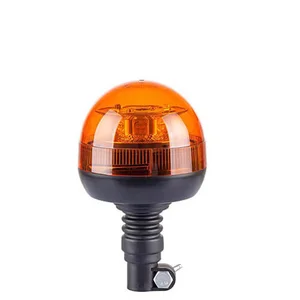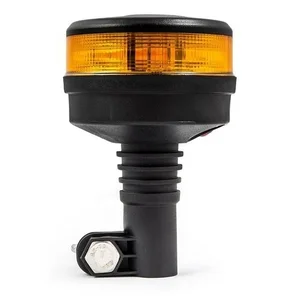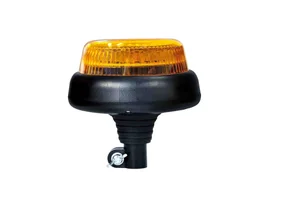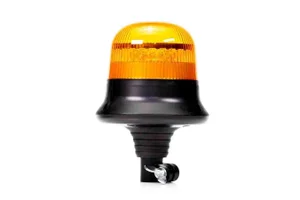You've probably seen them along the road, an orange beacon light. But when are you allowed to have orange beacon lights? And perhaps an even more important question: when are you allowed to use orange beacon lights? You might also wonder if there is a difference between LED and halogen beacon lights. Below you will find all the information you need to answer all these questions.

When to use flashing lights on trucks?
There is often still uncertainty about when you can use flashing lights. In order to prevent this, we have once again clearly listed all the situations. You may use orange flashing lights in the following situations:
- When working with assistance on or at the side of the road with motor vehicles equipped for this purpose.
- Work related to the road, think of the literal work on the road but also gritting in winter.
- In work involving the towing away of other vehicles.
- Accompanying transport for which exemption has been granted.
- For the guidance of military convoys
- When driving vehicles with limited speed, think of agricultural vehicles.
- Customs work.
When to use flashing lights on trucks?
When to flash the lights is also a frequently asked question. The above list shows the situations in which this is allowed.
Combination of orange and blue signaling lamps
It is also possible to see a combination of the above colours on a vehicle on the public highway. Many priority vehicles with blue flashing lights are also fitted with an orange variant. The blue light is activated when the vehicle requests priority from its road users, and the orange variant is used to indicate that the vehicle is in a hazardous location. This colour is used in combination when the vehicle is stationary.
Can you have orange flashing lights on public roads?
You may wonder whether you need a permit for driving with orange flashing lights. You don't need to worry about this. You do not need a permit. Of course, it is intended that the orange flashing lights are only used in the above situations. It is also important that the lights have the correct certification.
Can you have orange flashing lights on public roads?
Not every orange beacon light can be used on public roads. A beacon light may only be used if it is R65 certified. If you use a beacon light on the public road that does not have this certification, you risk receiving a fine.
Is orange the same as amber?
If you are looking for orange-coloured lighting, you have probably already come across the term amber Amber is in fact the name given to orange-coloured lighting. Amber comes from the English language and literally means amber. Amber has the well-known orange/yellow colour that you recognise in the lighting. The colour amber is therefore nothing more than the official name for the colour orange. When you see this, you know that it simply means an orange-coloured lamp.
Other colours of flashing lights
In addition to orange flashing lights, there are, of course, other colours. Orange is by far the most common colour when it comes to flashing lights. Besides orange, you may also have come across blue or green flashing lights. In other countries, it is also possible to see red flashing lights. In the Netherlands, the emergency services do not use red flashing lights.

Blue beacon lights
Blue flashing lights are most commonly associated with emergency services such as the police, fire brigade, and emergency medical services. When a vehicle uses blue lights, it must also have reflective striping, letters, numbers, or symbols to make it recognizable to other road users. It's important for all road users to recognize that a vehicle from one of these sectors is passing by. You can find more information about this in the article: Are you allowed to have a blue flashing light?
Green flashing lights
The green flashing lights are already a lot less common compared to the blue ones. The green flashing light may be used in addition to the other lights. The green colour may never be used on a moving vehicle. Only stationary vehicles may display green flashing lights. The green flashing lights are used to indicate the leading vehicle. These lights, like the blue ones, are only permitted for emergency services. The green lights show which vehicle belongs to the highest ranking officer.
Red flashing lights
In the Netherlands, red flashing lights are, in principle, not used. In other countries, some emergency services are still equipped with red lights. In the Netherlands, red flashing lights are not allowed to be used in traffic as this can lead to dangerous situations. The red colour is normally only found at the rear of a vehicle. When someone uses a red flashing light, it is visible on all sides of the vehicle. In this way, it is no longer clear to other road users in which direction the vehicle is driving. This can lead to dangerous situations, which is why the red flashing light is prohibited in traffic in the Netherlands.
Orange (amber) flashing lights
You have undoubtedly come across orange flashing lights in traffic. This is the most common colour. Many vehicles that work on or alongside the road carry orange flashing lights. Unlike the other colours of flashing lights on emergency vehicles, orange flashing lights do not have the right of way. You do not have to give way to a vehicle with orange flashing lights. The orange flashing lights can be used in the following situations:
Can you have orange flashing lights as a private person?
It is probably logical that you, as a private individual, are not allowed to use blue or green lights. These are intended for emergency services. When other vehicles also drive with green or blue lights, it is no longer clear what kind of vehicle is approaching or standing still.
But what about the orange flashing lights? Are private individuals allowed to have / use orange flashing lights? The answer to this question is quite simple. The law states that passenger cars may not have any other flashing lights with the exception of direction indicators, warning lights and brake lights for the emergency stop signal. This is stated in article 5.2.64. Put simply, as a private individual, you are not allowed to have or carry orange flashing lights. If you do have orange flashing lights, as a private individual, you will be fined.
R65 certification
A light requires R65 certification before it can be used on public roads. A flashing light is certified when it can be seen from all angles. The light must be visible from twenty metres from the vehicle at a height of one and a half metres. When certain objects block the light of an orange beacon, for example, a second beacon must be fitted.
Do you have a problem with malfunctions? Is the lamp R10 certified?
It can sometimes happen that a lamp causes interference in other equipment in the vicinity. Think about the radio in the car. This can start to interfere when the beacon is switched on. Fortunately, there is a certificate for this. Lamps are tested for this problem, and when it is proven that the lamp does not cause any interference, the lamp receives the R10 certification.
The R10 certification not only indicates that the lamp does not cause interference with other devices. It also indicates that the lamp itself is not sensitive to interference. If you want to be sure that your orange beacon light does not cause any disruptions, you should check if the beacon light is R10 certified.
Read our blog about disturbing the radio for more information on this.
Halogen vs LED beacons
Halogeen en LED zijn de meest voorkomende soorten zwaailampen. Hieronder vind je informatie over de twee verschillende soorten licht.
Halogeen zwaailampen
A halogen lamp uses a stationary bulb. A mirror rotates around this lamp and moves the light in different directions. Of course, the mirror does not rotate on its own; a small electric motor ensures that the mirror can rotate. Because of the multiple actions, a halogen beacon quickly uses 70-90 watts. In addition, the rotating parts wear out due to all the movements. These will need to be replaced after a while.
LED beacons
LED beacons are increasing enormously in popularity. This is because LED lights have many advantages. A LED beacon can display both a rotating light and a flashing light. LED lights consume less power and last longer. There are no moving parts in a LED beacon that can wear out. There are powerful LEDS around a reflector that is incorporated into the beacon. Each LED is controlled separately by electronics, which makes multiple patterns possible.

LED beacons from TRALERT®
TRALERT® has different colours and types of beacons in its product range. Besides the orange flashing lights, blue, green and red flashing lights are also available. Most flashing lights within the assortment are orange coloured. All these lights can be mounted in different ways.

Methods of assembly
TRALERT® LED beacons can be installed in a total of four different ways. There is a different option for every situation.
Fixed installation
De eerste manier om een zwaailamp aan je voertuig te monteren is door hem vast aan het voertuig te maken. Meestal gebeurd dit aan het dak van het voertuig. Het vastmaken wordt dan gedaan aan de hand van drie bouten. Met de drie bouten bevestig je de zwaailamp stevig op het voertuig.
Flexible DIN mounting
The flexible DIN mounting is a very easy form of mounting. It also ensures that the beacon is even more robust. The beacon is attached to a flexible stand. This allows the light to move with you, as it were. Any replacement of a bulb is also very easy with the DIN mounting. You can easily remove a light from the DIN base and then replace it with another or a new light.
Magnetic base/suction cup
The beacons with magnetic base are also very easy to attach to a vehicle. The magnet ensures that the lamp sticks to the roof. The suction cup that comes with it reinforces this even more. It ensures that the beacon is even more firmly attached to your vehicle.
Single bolt mounting
The single bolt assembly is, as the name suggests, a way of securing a beacon with one bolt. The fastening works the same as with the fixed assembly. The only difference is the number of bolts. With the fixed mounting, usually three bolts are used, with the single bolt mounting one bolt. One bolt is enough to mount a beacon securely on your vehicle.
In short, when to use an orange flashing light depends mainly on the situation. Not everyone is authorised to use an orange flashing light on their vehicle. Do you have any questions about our beacons or about the use of beacons? Feel free to contact us and we will help you.
The choice of TRALERT®
Hieronder ziet u onze selectie van goedgekeurde oranje zwaailampen.
Better Light Work Safer!





